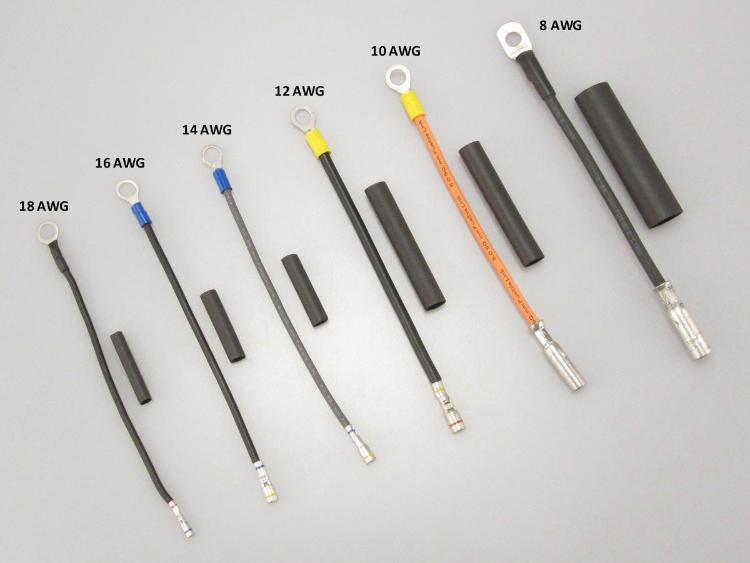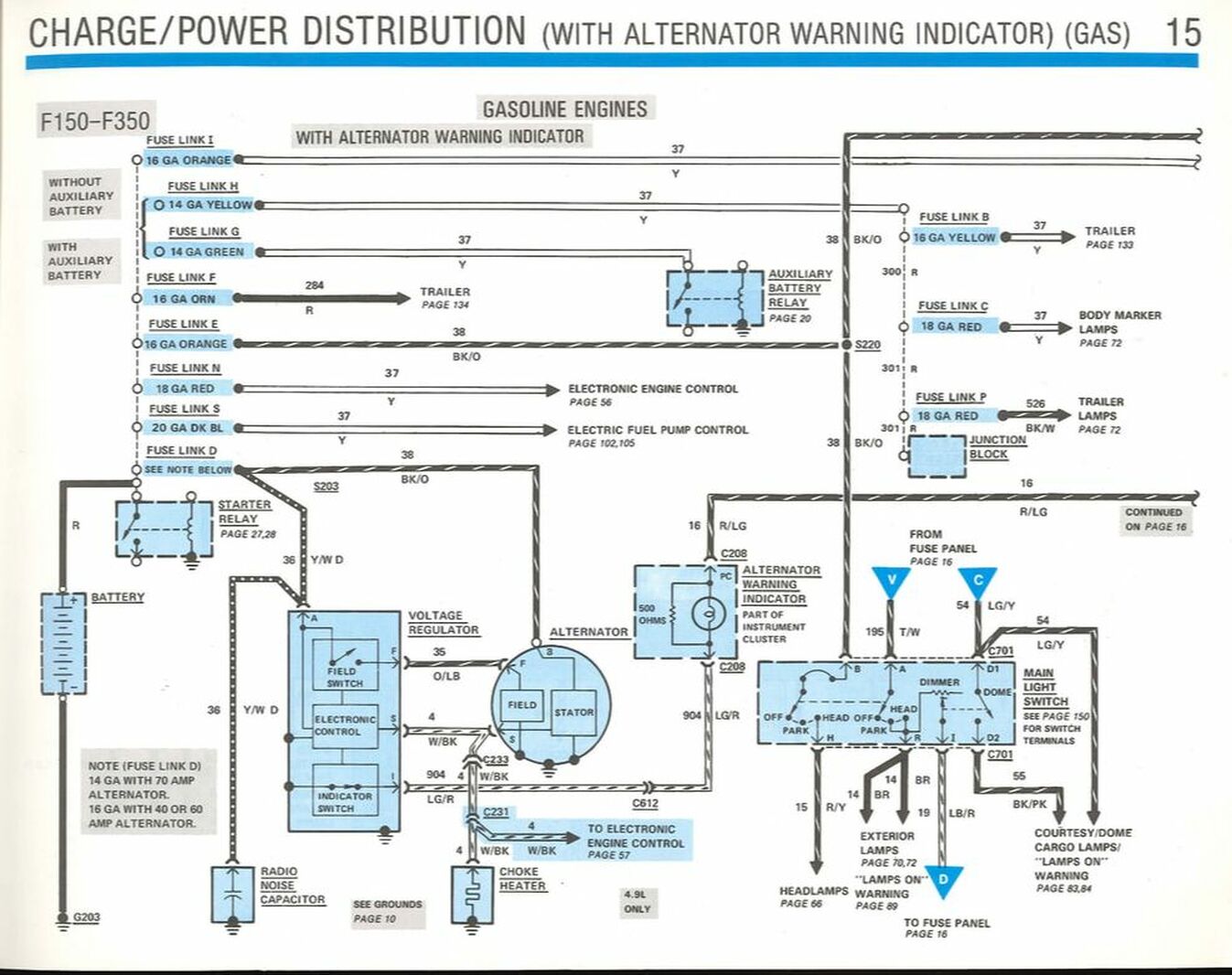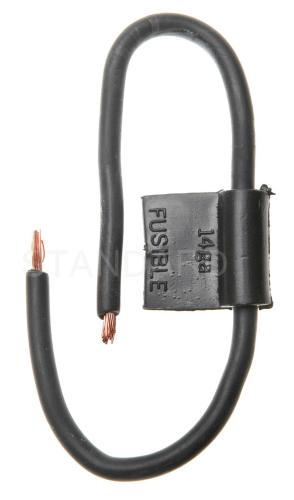About Fusible Links
|
Hi Gentlemen,
Little dummy class about famous Fusible Links, please? Questions: 1- Clarify their goal (compared to a normal circuit protected at the fuses panel); 2- Any difference between using a «fused wire» or a Fusible Link (see pictures); 3- Under the hood, how to see difference between a regular wire and a Fusible Link; 4- How determine how much «strong» a Fusible has to be, when replaced. 5- Can a Fusible Link simply prolong a regular longer wire. I suspect some are missing in Big Brother’s circuitry, and want to inspect this. Thanks for making me brighter!   
Jeff / 1984 F350 Crew Cab 4x4/5.8L w351 4V/ T18/ D50 4.10 front/ 8' bed.
Restored 2019-2022. Nicknamed «Big Brother 1984», due to its soooo-looong shape & nod to George Orwell's 1984 famous novel. |
|
Administrator
|
Questions:
1- Clarify their goal (compared to a normal circuit protected at the fuses panel); A fuse link, as Ford calls them, can take an overcurrent for far longer than a fuse can. So if you have a short or an overload the fuse will blow and the fuselink probably won't. 2- Any difference between using a «fused wire» or a Fusible Link (see pictures); Yes. A fused wire has a normal fuse in it and will blow much more quickly that a fuse link with a similar rating when you have a short or overload. 3- Under the hood, how to see difference between a regular wire and a Fusible Link; The EVTMs show where the fuse links are supposed to be, so you could check that way. But the insulation on a fuse link is different than that of a normal wire. It is probably a silicone-based plastic, and it feels rubbery and slick in comparison to the other wires. And there will be a splice at the end of it to the normal wire. 4- How determine how much «strong» a Fusible has to be, when replaced. Good question. The EVTM tells the color and the wire size of each fuse link, but not the length. So if you have one blown you just replace it with a fuse link wire of the same size and length. But if someone replaced a fuse link on your truck with regular wire it might not be the same length. 5- Can à Fusible Link simply prolong a regular longer wire. Sorry, I don't understand that question. 
Gary, AKA "Gary fellow": Profile
Dad's: '81 F150 Ranger XLT 4x4: Down for restomod: Full-roller "stroked 351M" w/Trick Flow heads & intake, EEC-V SEFI/E4OD/3.50 gears w/Kevlar clutches
|
|
Administrator
|
I've always had mixed feelings about fusible links. Pros and cons I guess but the thing on principle that I don't like about them is having something sacrificial being built into the circuit and not easily (side of the road, raining, dark) replaceable.
Sure an appropriately sized fuse, even a slow blow, may trip at the worst time but at least you can easily pop a new one in and maybe be clued into something amiss. That said, I still have mine in play in the 86. 
Scott
'Camano' 1986 F250 Supercab XLT Lariat 460/C6 'Chanute' 1980 F350 C&C 400/NP 435 - Gin Pole But there ain't nothin' wrong with the radio |
|
Administrator
|
Good points, Scott. And that's a lot of the reason that Big Blue doesn't have many fuse links. But he has two in parallel in the power feed from the passenger's side PDB to driver's side PDB. That's a stock link for a 90's Ford truck. That link crosses the radiator so seriously needs to be protected in case of an accident.
If I'd not found a factory link for that feed I would probably have made one and used a megafuse to protect it. Maybe something like the Littelfuse 0MEG150.XP MEGA BP Slo-Blo Automotive Bolt-Down Fuse. I'm not sure 150A would be enough as I can parallel the batteries and use both for starting or running the winch. But they make several sizes so I'm sure I could find the right one.
Gary, AKA "Gary fellow": Profile
Dad's: '81 F150 Ranger XLT 4x4: Down for restomod: Full-roller "stroked 351M" w/Trick Flow heads & intake, EEC-V SEFI/E4OD/3.50 gears w/Kevlar clutches
|
|
Thanks guys for your answers. I suspected something like that, but good to have my supposition confirmed by pros.
About my question #5: Can a Fusible Link be installed at the end of a «regular» wire. For exemple, a regular wire of 20" terminated at one extremity by a 4" Fusible Link. As the weakest link in a chain…. Or, a Fusible Link has to be full length (in that exemple 24").
Jeff / 1984 F350 Crew Cab 4x4/5.8L w351 4V/ T18/ D50 4.10 front/ 8' bed.
Restored 2019-2022. Nicknamed «Big Brother 1984», due to its soooo-looong shape & nod to George Orwell's 1984 famous novel. |
|
Administrator
|
I'm in no way a pro. But fuse links are usually installed at one end or the other of a regular wire. For instance, in the schematic below the fuse links that are connected to the starter relay then typically connect to a regular wire that goes on to carry a load.

Gary, AKA "Gary fellow": Profile
Dad's: '81 F150 Ranger XLT 4x4: Down for restomod: Full-roller "stroked 351M" w/Trick Flow heads & intake, EEC-V SEFI/E4OD/3.50 gears w/Kevlar clutches
|
|
Thanks Gary!
Exactly the info I was looking for! 
Jeff / 1984 F350 Crew Cab 4x4/5.8L w351 4V/ T18/ D50 4.10 front/ 8' bed.
Restored 2019-2022. Nicknamed «Big Brother 1984», due to its soooo-looong shape & nod to George Orwell's 1984 famous novel. |
|
Hope y'all don't mind a long response, I'm having a bachelor night tonight.
Fusible links should always be installed as physically close to the voltage source as possible. And they are short because of the nature of how they're made. A fusible link is just a regular fuse without the replaceable element and holder. Both perform the same job and function in precisely the same way - a short section of smaller-gauge wire "melts first" at a current below where a downstream wire would melt/catch fire. You could replace a fusible link with a regular fuse (of the appropriate size) or vice versa. Another way to think of it is a "normal" fuse is just a fusible link that's easier to replace! If fuses are so standard and easy to use, why use "fuselinks" at all? Well, what if a short circuit event "should almost never happen?" Say we're not talking about a lighting circuit, we just need to protect the main power feed to the fuse box under the dash? Everything downstream of the fuse box is already protected, we just need to protect the 5' of wire from the battery through the firewall. Now maybe our failure rates go from "1 in 100,000 per year" to "1 in 100,000,000 per year". They're very rare. Suddenly our priorities are different. For highly-unlikely events that you almost never have to fix, convenience is less important. Instead, we want something small, very cheap to install, and bulletproof. We don't want warranty calls for corroded contacts in a fuse that hardly ever gets replaced anyway. We don't want the bulk and cost of high-amp fuses and holders. And we sure as heck don't want some knucklehead sticking a 300A fuse where a 100A should go "because it keeps tripping and you know car makers always undersize everything." Enter the fusible link. A $5 word for a 5c concept. It's just a fuse without the holder and replaceable element. Take a look at a picture of a typical one:  The extra-thick insulation section is a dead giveaway in identifying one in a circuit. In all the fuselinks I've seen (except DIY ones), that is the part that "is" the "fusible link". The rest of the wire is just a pigtail that makes it easier to splice in. The length of the pigtail is not important. Fuselinks are so simple you can easily make your own. I believe the standard rule of thumb is to make the fusible section "4 wire gauges smaller" but you should do a little Googling - they're so cheap to buy that I haven't made one myself in like a decade. Do not use heat shrink if you make one - you can buy fiberglass sleeves that go over them to prevent fires. AeroElectric has a (really outdated, but still valid) guide: http://www.aeroelectric.com/articles/fuselink/fuselink.html Interesting side trivia. A common misunderstanding with fuses, fusible links, and breakers is that they protect devices or people. They do not - they protect wires. A fuse can't know the difference between a sudden, higher current draw due to running an air compressor plugged into your lighter socket or you sticking a fork in on a dare. Its job is just to prevent things from getting so out of hand that the wire TO the socket catches fire. And in my long-winded way, we're back to placement - that's why you install protective devices near the voltage SOURCE, not the device "protected". If you put a fuse 3' away from your battery you have 3' of unprotected wire that could short upstream of that fuse and cause that fire. These are definitely not "put them anywhere that works" devices. That's why you almost never see them anywhere else but the engine compartment. That's where the battery/alternator are.
--
1981 F-250 Custom. 6.6L V8, 4 barrel Holley carb, ARA aftermarket A/C. |
|
Administrator
|
That's a good writeup. Thanks!
Gary, AKA "Gary fellow": Profile
Dad's: '81 F150 Ranger XLT 4x4: Down for restomod: Full-roller "stroked 351M" w/Trick Flow heads & intake, EEC-V SEFI/E4OD/3.50 gears w/Kevlar clutches
|
|
In reply to this post by taskswap
This is what I call a comprehensive briefing!
Thank you so much! I’ll keep it in my archives, for sure!  I widely prefer to understand what I do than simply apply recipes. Following an electrical diagram while not understanding what I am doing, and why I’m doing it, makes me frustrated. Now, I feel more bright about these fuses of all kind questions. 
Jeff / 1984 F350 Crew Cab 4x4/5.8L w351 4V/ T18/ D50 4.10 front/ 8' bed.
Restored 2019-2022. Nicknamed «Big Brother 1984», due to its soooo-looong shape & nod to George Orwell's 1984 famous novel. |
| Edit this page |

